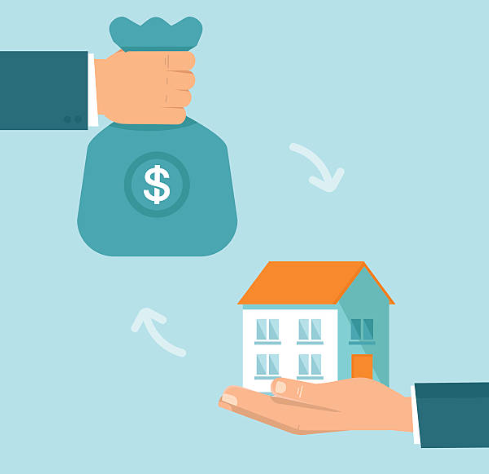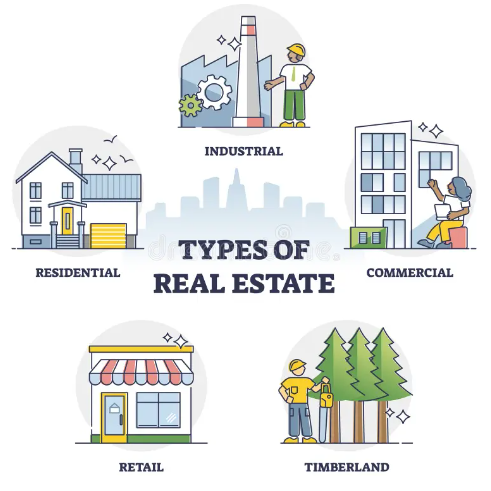What is Real Estate

Real estate include land and all permanent structures and natural features on it. This includes buildings, houses, trees, minerals, and bodies of water. It’s the physical space where people live, work, and conduct business. Real estate plays a crucial role in providing shelter, workspace, and investment opportunities. Whether it’s a suburban home, a downtown office building, real estate is essential to our daily lives and the economy. Understanding real estate helps us navigate property ownership, rental agreements, and investment decisions effectively.
Real estate is a concept that’s all around us, but what does it really mean? In simple terms, real estate is about land and everything connected to it. Imagine a piece of land with a house on it, surrounded by trees, maybe with a river flowing nearby. All of these elements—the land, the house, the trees, and the river—are part of real estate.
Access exclusive content on the moneymortal platform and stay informed with valuable updates.
Key Takeaway Points:
- Real estate encompasses land and any structures or resources attached to it.
- It serves various purposes, including residential, commercial, industrial, and agricultural.
- Real estate is a significant component of the economy, influencing sectors like construction, finance, and law.
- People invest in real estate through direct purchase, REITs, mutual funds, or crowdfunding platforms.
- Factors such as location, demand and supply, economic conditions, and property condition influence real estate prices.
What Are Types of Real Estate?

- Residential Real Estate: This is where people live. It includes houses, apartments, condos, and any other place where someone might call home. Residential real estate is all about providing comfortable and safe living spaces for individuals and families.
- Commercial Real Estate: This is where businesses operate. It includes office buildings, retail stores, restaurants, hotels, and any other property used for business purposes. Commercial real estate is essential for the economy because it provides spaces for businesses to serve customers, create products, and offer services.
- Industrial Real Estate: This is where things are made or stored. It includes factories, warehouses, distribution centers, and other industrial facilities. Industrial real estate is important for manufacturing and logistics, ensuring that goods are produced and delivered efficiently.
- Agricultural Real Estate: This is where crops are grown or animals are raised. It includes farms, ranches, orchards, and vineyards. Agricultural real estate plays a crucial role in food production, supplying fruits, vegetables, grains, and livestock to markets around the world.
- Land: This includes undeveloped property, vacant land, and agricultural lands such as farms, orchards, ranches, and timberland. Land is the base upon which everything else is built. Whether it’s an empty plot waiting for a house to be constructed or a vast expanse of farmland, land is a fundamental component of real estate.
- Special Purpose: This refers to property used by the public for specific purposes, such as cemeteries, government buildings, libraries, parks, places of worship, and schools. These properties serve important community functions, providing spaces for education, recreation, governance, and remembrance. Special purpose real estate is designed to meet the unique needs of society beyond just living and working.
Pros & Cons
| Pros | Cons |
| Potential for Growth: Real estate has the potential to increase in value over time, allowing investors to build wealth through appreciation. | illiquidity: Real estate investments are relatively illiquid, meaning they cannot be quickly converted to cash without significant time and effort. |
| Steady Income: Rental properties can provide a consistent source of income through monthly rent payments, offering financial stability. | High Initial Costs: Purchasing real estate often requires a large initial investment, including down payments, closing costs, and ongoing maintenance expenses. |
| Portfolio Diversification: Investing in real estate can diversify an investment portfolio, reducing risk by spreading investments across different asset classes. | Market Volatility: Real estate markets can be subject to fluctuations, influenced by factors such as economic conditions, interest rates, and local market trends. |
| Tangible Asset: Real estate is a tangible asset that you can see and touch, providing a sense of security and stability. | Property Management: Owning rental properties requires active management, including finding tenants, collecting rent, and handling maintenance and repairs. |
| Tax Benefits: Real estate investors may benefit from tax deductions such as mortgage interest, property taxes, and depreciation, reducing taxable income. | Risk of Vacancy: Rental properties may experience periods of vacancy, resulting in lost rental income and additional expenses for property owners. |
| Control over Investment: Real estate investors have control over their investments, allowing them to make decisions about property management, renovations, and rental rates. | Unexpected Expenses: Real estate ownership can come with unexpected expenses such as repairs, maintenance, and property taxes, impacting overall investment returns. |
Why Real Estate Matters?
Real estate matters for several reasons that affect our lives and the world around us. Here’s why it’s important in simple terms:
- Shelter: Real estate provides us with places to live. Whether it’s a cozy house, an apartment in the city, or a rural farm, real estate gives us shelter and a sense of security.
- Workspaces: Real estate also provides spaces for businesses to operate. From the corner store to big office buildings, businesses need places to work and serve customers. Without real estate, it would be hard for businesses to exist.
- Investment: Real estate can be a good way to invest our money. When we buy a property, its value can go up over time, allowing us to sell it for more money later on. Some people buy real estate as a way to save for the future or make extra money by renting it out to others.
- Economic Impact: Real estate is a big part of the economy. When people buy, sell, or rent properties, money changes hands, which helps keep the economy going. Real estate also creates jobs for people who build, maintain, and sell properties.
- Community Spaces: Real estate includes places like parks, schools, libraries, and places of worship. These spaces bring people together and help communities thrive. They provide places for learning, recreation, and socializing.
Overall, real estate matters because it affects where we live, where we work, how we invest our money, and how our communities function. It’s a big part of our lives, even if we don’t always think about it.
Different ways of using Real Estate
- Ownership: Some people buy real estate to own it outright. They might buy a house to live in themselves or a building to use for their business. Owning real estate gives them control over the property and the freedom to use it as they wish.
- Renting: Others choose to rent real estate instead of buying it. When you rent, you pay money to live or work in a property owned by someone else. Renting is like borrowing the property for a while without owning it. It’s a good option for people who want flexibility or can’t afford to buy.
- Investing: Some people buy real estate as an investment. They might buy properties to rent out to others, earning rental income. Or they might buy properties and sell them later for a profit if the property value goes up. Investing in real estate can be a way to make money over time and build wealth.
- Flipping: Another way people use real estate is by flipping properties. This means buying a property, fixing it up or making improvements, and then selling it quickly for a profit. Flipping can be risky, but it can also be a way to make a lot of money if done right.
Story behind Real Estate business
The story behind the real estate business is one of ambition, opportunity, and the pursuit of the American dream. It’s a tale of individuals seeking to build wealth, find homes, and create communities. Real estate is not just about buying and selling properties; it’s about shaping the places where we live, work, and play.
In the early days of settlement, real estate was about staking claims to land and building homes from scratch. Families would journey across vast expanses of land, seeking opportunities to start anew. They would clear forests, till fields, and construct homes with their own hands, laying the foundations for towns and cities to come.
As the population grew and cities expanded, real estate became a booming business. Entrepreneurs bought and sold parcels of land, developed neighborhoods, and built skyscrapers that reached towards the sky. Immigrants arrived in search of better lives, and real estate provided them with places to call home and opportunities to build businesses.
Over time, the real estate business evolved, becoming more complex and interconnected. Agents, brokers, developers, and investors worked together to buy, sell, lease, and manage properties of all kinds. From residential homes to commercial buildings, industrial parks to agricultural land, real estate became a cornerstone of the economy.
Today, the real estate business continues to thrive, driven by innovation, technology, and changing demographics. People are always looking for places to live, work, and invest, and real estate provides them with opportunities to do just that. Whether it’s buying a starter home, leasing office space for a new business, or investing in a rental property, real estate offers something for everyone.
But beyond the transactions and the bottom line, the real story behind the real estate business is one of people and communities coming together to build something greater than themselves. It’s about creating places where families can grow, businesses can prosper, and dreams can become reality. And in the end, that’s what makes real estate truly special.
Conclusion
In conclusion, real estate is a crucial part of our lives and society. It provides us with places to live, work, and play, shaping our daily experiences and interactions. From cozy homes to bustling commercial spaces, real estate serves various needs and purposes, contributing to the economy and the well-being of individuals and communities. While real estate offers opportunities for growth, investment, and stability, it also comes with challenges such as market fluctuations, maintenance costs, and property management. Understanding the importance of real estate and its impact on our lives can help us make informed decisions and navigate the complexities of this essential aspect of our world.
FAQ’s
What is the difference between buying and renting a home?
Buying a home means you own it outright. You make monthly mortgage payments to a bank until you’ve paid off the loan. Once you own it, you can live there as long as you want. Renting, on the other hand, means you pay a landlord to live in their property. You don’t own the home, so you can’t make major changes to it. Renting is like borrowing the place for a while.
How can I invest in real estate?
There are a few ways to invest in real estate. One way is to buy properties and rent them out to tenants. You earn money from the rent they pay you. Another way is to buy shares in a real estate investment trust (REIT). This is like buying a piece of a big real estate portfolio managed by professionals. You can also invest in real estate mutual funds, which pool money from lots of investors to buy different properties.
What factors should I consider when buying a home?
When buying a home, there are several things to think about. First, consider your budget and how much you can afford to spend on a house. Then, think about the location—do you want to live in the city, suburbs, or countryside? Consider the size of the home and how many bedrooms and bathrooms you need. It’s also important to think about the condition of the property and if any repairs or renovations are needed. Finally, consider factors like schools, amenities, and future resale value.
